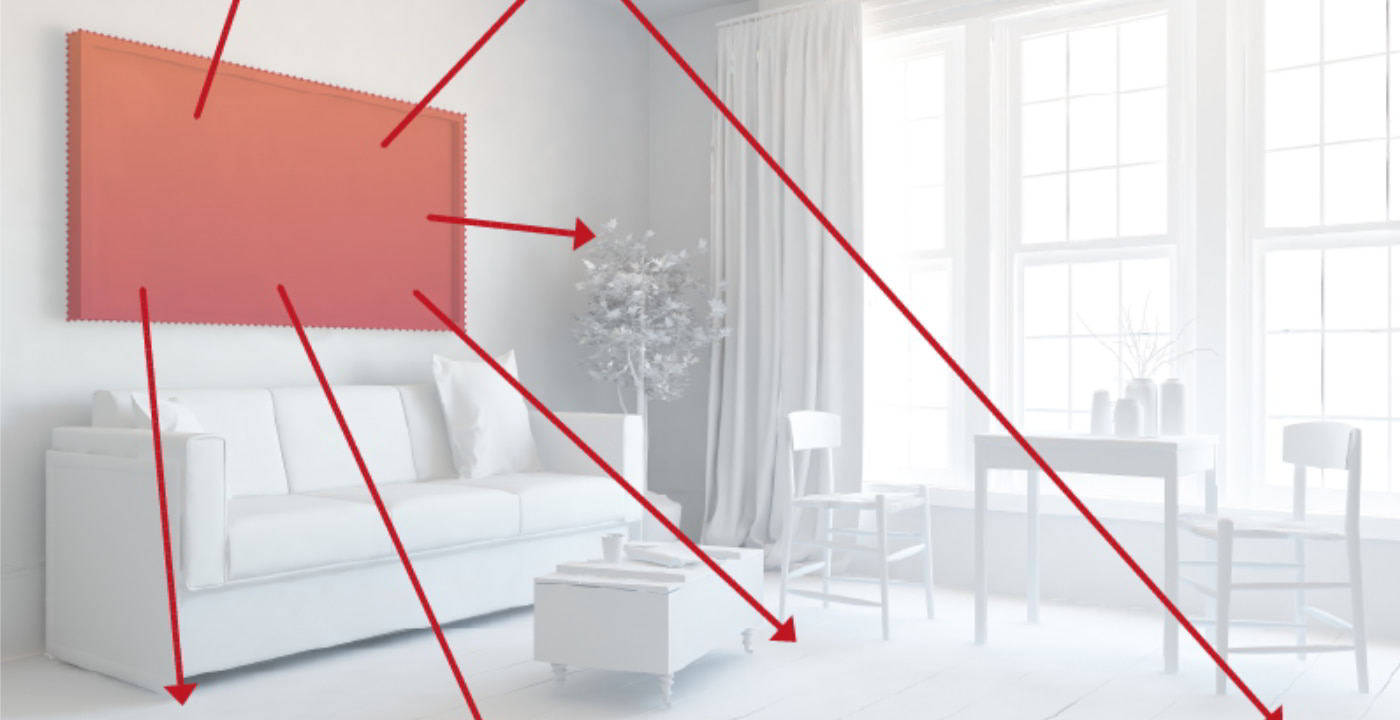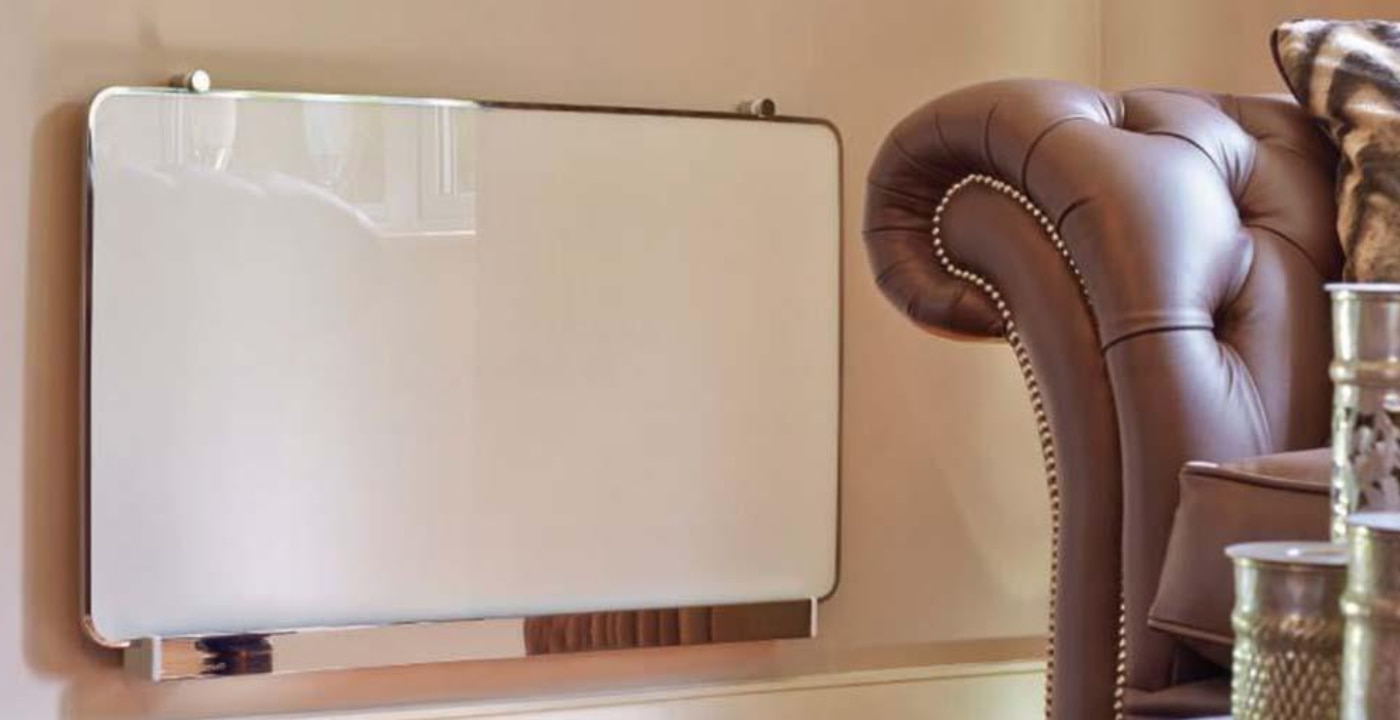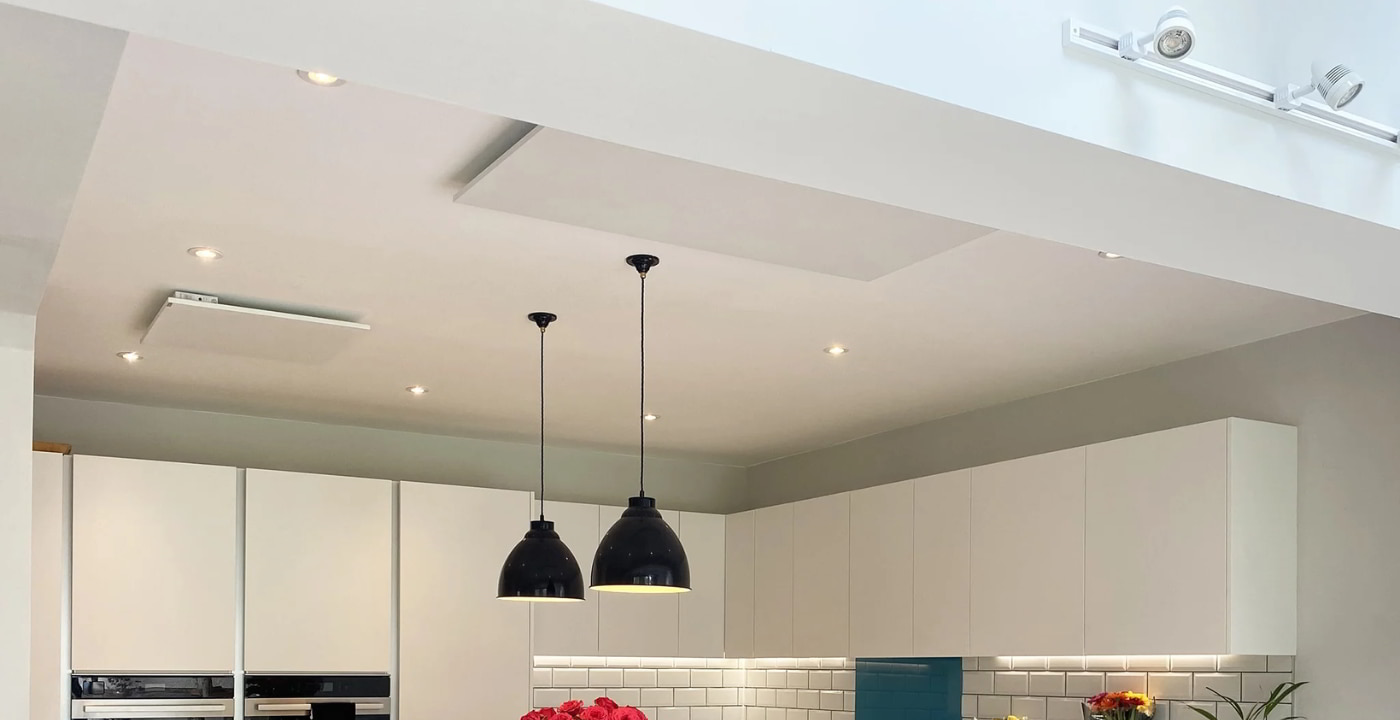Key Takeaways
- Infrared heating panels use infrared radiation to heat objects directly, resulting in efficient and comfortable heating.
- They offer energy efficiency by minimizing heat loss to the surrounding air and allowing for zoning to focus heat where it’s needed.
- Infrared heating panels can be used as whole-house heating systems or as supplementary heaters to enhance comfort in specific areas.
- They are easy to install, require minimal maintenance, and offer long lifespans.
How Do Infrared Heating Panels Work?

Infrared heating panels, also commonly referred to as radiant heat panels, work by emitting infrared radiation, which is a form of electromagnetic radiation.
This radiation travels in waves and directly heats objects and surfaces in its path, rather than heating the surrounding air.
The objects (and people) absorb the heat and then re-radiate it back into the room, creating a comfortable and even warmth.
The heat generated by infrared panels is similar to the natural heat we receive from the sun, but without the harmful ultraviolet (UV) rays.
What are the Benefits of Infrared Heating Panels?

Infrared heating panels offer a range of benefits that make them a popular choice for homeowners. Here are some key advantages:
Energy Efficiency
Infrared heating panels are highly energy efficient due to their ability to directly heat objects and surfaces.
This direct heating process reduces heat loss to the surrounding air, resulting in more efficient and effective heating.
Unlike traditional heating methods that rely on heating the air, infrared panels provide warmth exactly where it’s needed, eliminating energy waste.
Comfortable and Healthy Heating
Infrared heating panels provide comfortable warmth without drying out the air or circulating dust and allergens.
Unlike convection heaters, which can create air currents and uneven heating, infrared panels produce a gentle and consistent heat that is evenly distributed throughout the room.
This type of heating is particularly beneficial for individuals with respiratory issues or allergies.
Zoning Capabilities
One of the significant advantages of infrared heating panels is their ability to be zoned.
Zoning allows you to direct heat to specific areas or rooms in your home, providing customized comfort and energy savings.
By installing multiple panels and controlling them individually or in groups, you can tailor the heating to match the occupancy and temperature requirements of different spaces.
Space-Saving Design
Infrared heating panels are designed to be wall-mounted or ceiling-mounted, allowing them to blend seamlessly into your living space.
Unlike traditional radiators or space heaters that take up valuable floor space, infrared panels are sleek and unobtrusive, offering a space-saving heating solution.
Cost-Effective Heating
Infrared heating panels are cost-effective in several ways.
Their energy efficiency helps reduce heating costs by minimizing energy waste.
Additionally, the targeted heating and zoning capabilities allow you to heat specific areas rather than the entire home, further optimizing energy usage and saving on utility bills.
With long lifespans and minimal maintenance requirements, infrared panels also offer cost savings in the long run.
Types of Infrared Heating Panels

Infrared heating panels come in various types to suit different heating needs and preferences. Here are the main types you may encounter:
Far Infrared Heating Panels
Far infrared panels emit far-infrared radiation, which provides a gentle and comfortable warmth.
They are suitable for indoor use, where they can deliver a subtle and deep level of heating.
Far infrared radiant heat panels are often used in residential spaces, such as living rooms, bedrooms, and bathrooms.
We’ve identified the Herschel Inspire Picture Radiant Heat Panel to be the best overall panel heater for your home. Not only is it designed to suit any room with it’s customizable image, but it uses innovative energy efficient radiant heating technology to keep your home aptly heated for the ultimate comfort.
If you want to find more of the heat panels to suit your space and your unique needs, we’ve written a guide identifying the best infrared radiant heating panels of 2023.
Longwave Infrared Heating Panels
Longwave infrared panels emit slightly more intense heat and can project warmth over larger areas.
They are ideal for open-plan spaces, warehouses, workshops, and other areas where a broader coverage is desired.
Near Infrared Heating Panels
Near infrared panels, also known as shortwave infrared panels, emit robust heat and are commonly used for outdoor heating applications.
They provide vigorous warmth and are often accompanied by a strong, visible light. Near infrared panels are popular for heating outdoor patios, terraces, or commercial spaces with open entrances.
Factors to Consider When Choosing Infrared Heating Panels
When selecting infrared heating panels for your home, there are several factors to consider to ensure the right fit for your heating needs. Here are some key considerations:
Heating Capacity
Determine the heating capacity required for the intended space.
Consider factors such as room size, insulation quality, ceiling height, and the desired temperature.
Manufacturers typically provide guidelines on the heating capacity of their panels, making it easier to choose the appropriate size and wattage.
Installation Method
Decide whether you prefer wall-mounted or ceiling-mounted panels.
Wall-mounted panels are the most common choice and offer easy installation.
Ceiling-mounted panels, on the other hand, provide overhead heating and can be suitable for spaces with limited wall space or specific heating requirements.
Energy Efficiency and Certifications
Check the energy efficiency rating of the panels and ensure they meet relevant certifications and standards.
Look for Energy Star or equivalent certifications to ensure you are choosing energy-efficient panels that comply with industry standards.
Control Options and Thermostats
Consider the control options and thermostat compatibility of the panels.
Some panels come with built-in thermostats or digital controls, while others can be connected to external thermostats for precise temperature management.
Explore the control features that align with your preferences and heating requirements.
Aesthetics and Design
Infrared heating panels come in various designs, finishes, and colors.
Consider the aesthetics of the panels and how well they integrate with your interior decor.
Look for panels that offer a sleek and modern appearance while providing efficient heating.
You can also consider installing mirrored radiant heat panels, plus some are entirely customizable and can have any design you might want.
Cost Efficiency of Infrared Heating Panels
One of the primary concerns for homeowners is the cost of running infrared heating panels.
Let’s delve into the cost efficiency aspects:
Digital Thermostats and Energy Management
Pairing infrared heating panels with digital thermostats further enhances cost efficiency.
Digital thermostats offer precise temperature control and scheduling options, allowing you to optimize energy management.
You can set customized heating schedules, adjust temperatures remotely, and minimize energy waste by ensuring the panels operate only when needed.
Potential Energy Savings
Compared to other electric heating systems, infrared heaters offer significant energy savings.
It is estimated that an infrared heater can use about 40% less energy to achieve the same level of comfort.
By choosing infrared heating panels, you can potentially lower your electric bills and reduce overall energy consumption.
Energy Consumption and Cost Comparison: Infrared Heating Panels vs. Convection Heaters
To provide a better understanding of the potential cost savings, let’s examine a comparison between infrared heating panels and conventional electric heating systems
| Type of Heater | Energy Consumption (kWh) | Monthly Cost ($) |
|---|---|---|
| Conventional Electric Heater | 500 kWh | $80 |
| Infrared Heating Panel | 300 kWh | $48 |
| Savings | 200 kWh | $32 |
Average Annual Energy Savings with Infrared Heating Panels
| House Size | Average Annual Energy Savings (kWh) | Annual Cost Savings ($) |
|---|---|---|
| Small (1-2 bedrooms) | 1,200 kWh | $192 |
| Medium (3-4 bedrooms) | 2,400 kWh | $384 |
| Large (5+ bedrooms) | 3,600 kWh | $576 |
Cost Savings with Infrared Heating Panels Over 5 Years
| House Size | Total Cost Savings over 5 Years ($) |
|---|---|
| Small (1-2 bedrooms) | $960 |
| Medium (3-4 bedrooms) | $1,920 |
| Large (5+ bedrooms) | $2,880 |
As shown in the tables above, infrared heating panels demonstrate lower energy consumption and associated costs when compared to traditional home heating systems..
The precise savings will vary depending on factors such as room size, insulation, climate, and usage patterns, but the overall cost efficiency of infrared panels is clearly evident.
Heating a Whole House with Infrared Panels

One common question is whether infrared panels can effectively heat an entire house. Let’s explore the possibilities.
Infrared panels can indeed heat a whole house, but the approach may differ from conventional heating systems.
Due to their targeted heating nature, infrared panels are often used as part of a comprehensive heating strategy rather than the sole heating source.
Here are a few considerations:
Complementary Heating
Infrared panels can serve as complementary heaters alongside existing heating systems.
By strategically installing panels in key areas or rooms, you can enhance the overall heating performance and improve comfort levels.
This approach allows you to reduce reliance on the primary heating system while providing efficient and zone-specific warmth.
Zoning for Efficiency
Zoning capabilities of infrared panels make it possible to heat specific zones or areas of the house, providing customized comfort and energy savings.
By zoning the heating, you can direct warmth to frequently used spaces while maintaining lower temperatures in less occupied areas.
This zoning approach optimizes energy usage and reduces heating costs.
Whole-House Heating Systems
Infrared panels can also be used as the primary heating system for smaller homes or well-insulated properties.
With proper planning and installation, a network of infrared panels can deliver consistent and efficient heating throughout the house.
However, it is crucial to ensure adequate panel placement and sizing to achieve balanced and uniform heating.
FAQs
Can you heat a whole house with infrared panels?
It is possible to heat smaller homes and apartments entirely with infrared panels, but they must be extremely well insulated. For larger properties you may want to consider combining infrared panels with underfloor radiant heating.
Are infrared heating panels expensive to run?
As we have seen, infrared panel heaters are cheaper to run than many alternative heating solutions, but the cost to run heating panels will vary depending on your energy provider and the current price of electricity.
Do infrared heaters raise your electric bill?
Typically, no, infrared heaters should lower your electric bill, rather than raise it. However, this is entirely dependent on energy prices.
Unless, of course, you already have access to renewable energy like solar, in which case you’re all good.
How long does it take for an infrared heater to heat a room?
On average it takes no longer for a room to reach its target temperature when heated by infrared heating panels for the home.
Conclusion
Infrared heating panels offer a modern, efficient, and customizable heating solution for homes.
Their ability to directly heat objects, energy efficiency, zoning capabilities, and comfortable warmth make them an attractive choice for homeowners seeking cost-effective and eco-friendly heating options.
By carefully considering factors such as heating capacity, installation methods, energy efficiency, and control options, you can select the right infrared heating panels for your home and enjoy the benefits of efficient and tailored heating.
Remember, when purchasing infrared heating panels, choose reputable manufacturers and consult with professionals to ensure proper installation and optimum performance.
If you are interested in having infrared panels, or other radiant heating solutions such as underfloor heating or radiant countertop heaters, come and give us a visit at Green Wave Distribution, one of America’s leading experts in high-performance building products and renewable heating systems.





